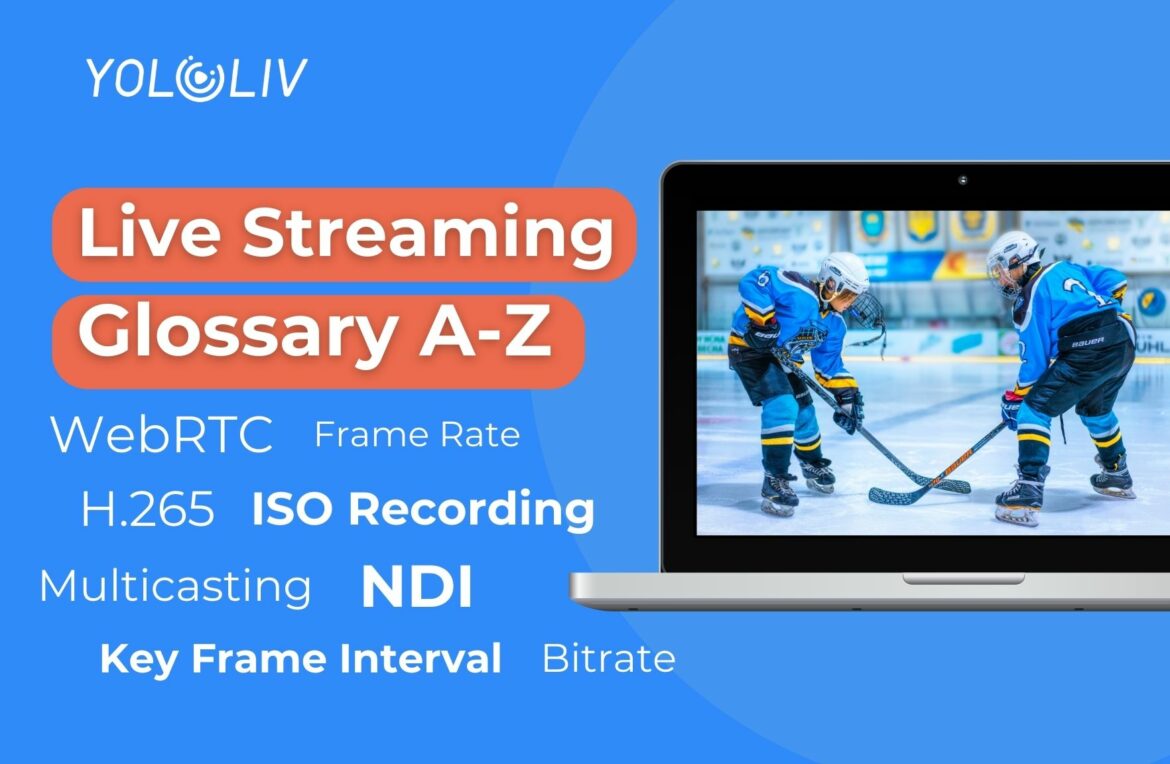This blog post aims to explain several essential terms and acronyms commonly used in the world of live streaming.
Understanding these terms used in the industry will enable you to effectively navigate the technology, address any potential challenges, and enhance the overall quality of your live streams.
Below are definitions of some of the most commonly used and significant streaming terms. Check out and get started learning today!
A
What is AAC?
Also known as Advanced Audio Coding, is the default or standard audio format across all media platforms, similar to MP3, that features increased sample frequency and offers a higher quality audio track for your live video.
B
What is Bitrate?
Bitrate refers to the rate at which audio and video data, compressed into packets (defined below), is sent from a streaming device to a streaming service’s CDN (defined below). In plain English, it’s the speed in which your data, or video, flies across the Internet. Higher bitrates generally result in better video quality but require a stronger internet connection. If your bitrate is too slow it may result in a poor quality video which may lag or look distorted.
It’s important to distinguish bitrate from resolution (defined below). While video resolution is largely determined by the camera’s capabilities itself, video bitrate is the amount of data that a streaming device can send. Both, however, affect your overall stream quality.
What is Bandwidth?
Typically measured in bitrates, bandwidth refers to the amount of data that can be transferred from one location to another in a given amount of time.
What is Buffering?
Before a video can play, a certain amount of pre-loading data must be downloaded to stream.
C
What is CDN?
A CDN (Content Delivery Network) is a means of efficiently distributing content around the globe. It helps offload the burden of serving content (video files, web pages, etc.) from a single server to a large network of distributed servers.
E
What is Encoder?
An encoder is a device or software that converts the audio and video signals into a digital format suitable for live streaming. It compresses the data and sends it to a streaming platform for distribution.
What is Encoding?
Encoding is the process of converting from a video source to a format that can be streamed over the Internet. Example: YoloBox (all-in-one live streaming encoder) will convert a video source to H.264/AAC to be displayed on a livestream player or mobile device.
F
What is Frame Rate?
Frame rate refers to the number of individual frames, or images, displayed per second in a video. It represents the speed at which consecutive frames are presented to create the illusion of motion. Frame rate is typically measured in frames per second (fps).
Frame rate directly affects compression, and is one of the main factors in encoder settings. The two most common frame rates are 30 FPS and 60 FPS.
H
What is H.264?
H.264, also known as AVC (Advanced Video Coding), is a widely adopted video compression standard that offers efficient video encoding and decoding. It provides a good balance between video quality and file size, making it suitable for various applications such as video streaming, video conferencing, broadcasting, and video storage.
What is H.265?
H.265, also known as HEVC (High-Efficiency Video Coding), is the successor to H.264 and offers even more efficient video compression. HEVC provides significantly improved compression capabilities, allowing for higher quality video at lower bitrates compared to H.264. This makes it ideal for applications with limited bandwidth or storage capacities.
With HEVC, it achieves a remarkable reduction of over 50% in bandwidth requirements while preserving the highest video quality.
H.265, also known as HEVC (High-Efficiency Video Coding), offers greatly improved video quality wherever the original H.264 bitrate is maintained, saving more than 50% of your bandwidth compared with H.264 under the same conditions.
I
What is ISO Recording?
It’s the abbreviation of ‘Isolated Recording.’ ISO Recording allows you to record all camera sources simultaneously and separately during a multi-camera production and can be edited together in post-production.
What is IP Camera?
A digital camera that sends and receives video data over your network, rather than via a capture device. With the NDI feature on YoloBox Ultra, you can capture the IP camera and add it as a video source under the same netwok.
What is Ingest?
In the context of live streaming, “ingest” refers to the process of capturing or receiving the video and audio content from its source and preparing it for distribution over the internet to viewers in real-time.
The term “ingest” is commonly associated with “ingest servers,” which are responsible for receiving the streaming feed and performing two main functions: storing the content or delivering it to the live audience.
K
What is Key Frames?
Also known as I-Frames, key frames are completely processed frames of digital video. They are the largest frames to process, since there’s no prediction used to display them. Key frames are the base from which delta frames predict motion and copy objects. Within encoding settings, key frame duration is an important one to consider; in general, forcing a key frame every two seconds is optimal for live streaming.
What is Key Frame Interval?
Key Frame Interval, also known as I-frame interval or IDR (Instantaneous Decoder Refresh) interval, is a parameter in video encoding that determines the frequency at which key frames, or I-frames, are inserted in a video stream.
In video compression, a key frame is a complete frame that can be independently decoded and displayed without reference to other frames. It contains the entire picture information and serves as a reference point for subsequent frames. They are typically used to detect changes in the video, such as movement of a talking head. In contrast, non-key frames, such as P-frames (Predicted frames) and B-frames (Bi-directional frames), only store the changes or differences from the previous frames.
The Key Frame Interval represents the number of frames between two successive key frames in a video stream. A smaller interval means more frequent key frames, while a larger interval means fewer key frames. Typically, a key frame is placed at the beginning of a video sequence and periodically throughout the video to provide points of reference for decoding and error recovery.
M
What is Multicasting/Multistreaming?
Multicasting or Multistreaming is the simultaneous distribution of a live stream to multiple streaming platforms or social media channels. It enables content creators to expand their reach and engage with a broader audience.
N
What is NDI?
NDI stands for Network Device Interface, which is a technology developed by NewTek for transmitting high-quality video, audio, and data over standard computer networks. NDI allows for the seamless and low-latency transfer of video and other media between devices and software applications over IP (Internet Protocol) networks.
P
What is a Packet?
Packets are the most basic unit of information transport in modern computer networks.
When data is sent from one place to another over the internet, it is divided into smaller packets and routed to its final destination. Each packet might use different routes through the internet to its destination. When they have all arrived, they are reassembled.
What is Packet Loss?
Packet loss refers to the situation where one or more transmitted packets fail to reach their intended destination. It occurs at some point between when your live streaming encoder sends the data and when the data is expected to be received by the server.
R
RTMP (Realtime Messaging Protocol)
It’s a protocol used for streaming audio, video and data over the Internet between a Flash player and a server. Commonly used by Adobe Flash Media Encoder, NewTek Tricaster, and Telestream Wirecast.
What is Resolution?
Resolution refers to the number of individual pixels (the smallest element of an image) that make up the full video screen. Specs like 4K, 1080i, 1080p, 720p, 480i, 480p, etc. all refer to the video resolution that a camera (or other video source), can record and output.
In the case of 1920×1080, the image captured is 1,920 pixels wide by 1,080 pixels in height. The larger this number, the more detailed and clear your stream will be.
S
What is SRT?
SRT stands for Secure Reliable Transport, which is an open-source protocol developed by Haivision for the reliable and secure transmission of video, audio, and other media over IP networks. SRT is designed to address the challenges of transmitting high-quality content over unpredictable network conditions, including high latency, packet loss, and limited bandwidth.
What is SDI?
SDI, which stands for Serial Digital Interface, refers to a type of cable commonly used for transmitting high-definition video signals. It supports various video formats, including standard definition (SD), high definition (HD), and even ultra-high definition (UHD) resolutions.
While an HD-SDI cable shares functional similarities with an HDMI cable, it offers distinct advantages that make it a preferred choice, particularly for professional video equipment.
When plugged into a device’s port, the HD-SDI cable locks in place, ensuring a stable and reliable connection. This feature prevents accidental dislodging or interruptions in the signal transmission. Additionally, HD-SDI cables have an extended transmission range. They can carry signals for up to 300 meters without requiring signal boosters or extensions.
V
What is VOD?
VOD, also know as Video on Demand, refers to pre-recorded content that viewers can access at their convenience. Many live streaming platforms also offer the option to save and watch streams as VOD after the live event has ended.
W
What is WebRTC?
WebRTC, or Web Real-Time Communications is an open-source project for streamlining real-time audio and video communication between two parties over the Internet. It enables voice and video calling directly inside a web browser without a plugin or installation via a JavaScript code run from your HTML page.
25,491 total views, 59 views today

As product operation manager at YoloLiv, Esther and her team stay focused on our customers’ needs and constantly push forward new updates for YoloBox and Pro. Also, she contributed some blog posts from perspectives on how to enhance live streaming experience, live streaming sop for newbies, and more.


